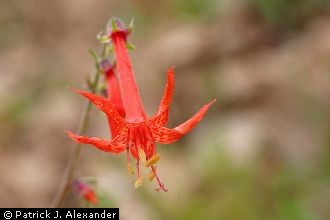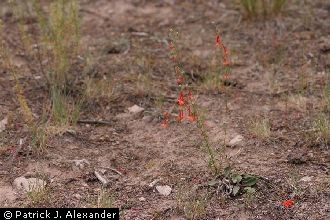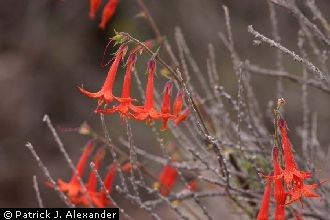Scarlet Gilia
Scientific Name: Ipomopsis aggregata (Pursh) V.E. Grant

| General Information | |
|---|---|
| Usda Symbol | IPAG |
| Group | Dicot |
| Life Cycle | BiennialPerennial, |
| Growth Habits | Forb/herb |
| Native Locations | IPAG |
Plant Guide
Description
General: Phlox Family (Polemoniaceae). Scarlet gilia is a biennial to short-lived perennial forb arising from a basal rosette and taproot. Individual plants remain in rosette form for one to many years and typically die after flowering (Fertig, 2017). Scarlet gilia’s lifespan varies, but one study found an average lifespan of 4.8 years with no plants surviving after ten years (Campbel, 1997). In production trials conducted at Rocky Mountain Research Station, the proportion of plants behaving as biennials was approximately 99%. A very few were noted as possibly carrying over to the following year, but those may have been seed that germinated a year later (Jensen, 2017). Mature plants can reach as much as 1 m (3 ft) tall, but plants typically range from 0.5 to 0.6 m (18 to 24 in) in height. The basal leaves are 2 to 8 cm (0.8 to 3.1 in) long and highly pinnatifid with narrow segments. The stem leaves reduce further up the stem. The flowers are typically scarlet as in varieties aggregata, arizonica and maculata, but can be white, salmon or pink in variety macrosiphon. Flowers are long tubular (1.5 to 5 cm long) with five spreading petals. The fruit is a 5 to 10 mm (0.2 to 0.4 in) capsule bearing 1 to several, 2 to 4 mm long seeds. As is typical in the phlox family, the seeds become mucilaginous (slimy) when wet (Welsh et al., 2003). Jensen (2017) reported that from 36 collections, seed weights ranged from 280,000 to 700,000 seeds/lb. Distribution: Scarlet gilia is located throughout western North America from Montana south to Texas and west to British Columbia south to California. For current distribution, please consult the Plant Profile page for this species on the PLANTS Web site.
Adaptation
Scarlet gilia is typically found in sunny openings in mountain shrub, sagebrush steppe, and alpine timber communities from 1,100 to 3,300 m (3,600 to 10,800 ft) elevations in the Sierra, Intermountain and Rocky Mountain regions (Hickman, 1993; Welsh et al., 2003). It is very drought tolerant, shade intolerant, and has higher germination success and seedling survival in disturbed soils (Juenger and Bergelson, 2000). Scarlet gilia prefers medium to coarse loam to sandy loam soils in areas receiving 250 to 1,000 mm (10 to 40 in) mean annual precipitation.
Uses
Wildlife: Scarlet gilia can be included in conservation and wildlife habitat plantings to increase species diversity. Plants are highly palatable, with the flowering stocks regularly utilized by native wildlife and livestock (Fertig, 2017). The timing of herbivory can influence plant response, with overcompensation (increased flower and seed production compared to non-grazed plants) observed with early season herbivory and reduced flowers and seed production with late season herbivory (Paige and Whitham, 1987; Paige 1999). Pollinator: Hummingbirds and bumblebees are attracted to this showy species from which they extract nectar (Irwin, 1998). Caruso (1999) documented visitation by broad-tailed (Selasphorus platycercus) and rufous (Selasphorus rufus) hummingbirds at a study site in Colorado. Scarlet gilia typically flowers in early- to mid-summer depending on the region. In the Intermountain and Rocky Mountain West, flowering dates ranged from April to July (Jensen, 2017). Flowers are self-incompatible and rely on cross pollination for seed production (Wolf et al 1986).
Status
Please consult the PLANTS Web site (http://plants.usda.gov/) and your state’s Department of Natural Resources for this plant’s current status (e.g., threatened or endangered species, state noxious status, and wetland indicator values).
Planting Guidelines
Based on a seeding rate of 50 pure live seeds (PLS) per foot, the full stand seeding rate is approximately 6 lbs/ac. The seeding rate should be adjusted to match the desired percentage within a seed mixture. Seed can be planted with a drill or broadcast seeder. Very shallow seeding depths, on the surface to no more than 3 mm (1/8 in) are typically recommended; however, Jensen (2017) observed no differences in emergence when planted at depths between 1.5 and 4 cm. Juenger and Bergelson (2000) found that tilling prior to broadcast seeding increased establishment significantly. In a 2017 field trial conducted by the authors in Idaho and Utah (results in preparation), germination rates of scarlet gilia were increased significantly using a mixture of cold and warm stratification over 10-day periods. In the same trials, coating scarlet gilia seed with a broad-spectrum fungicide (Obvius®, BASF Corporation, North Carolina, USA) also resulted in significantly higher rates of seedling emergence compared to a non-treated control. At sites that received 325 to 485 mm (13 to 19 in) annual precipitation, establishment of scarlet gilia seedlings within the first year of seeding was relatively high, with 40% of seedlings surviving during the first growing season.
Management
Scarlet gilia should be used as a minor component of pollinator and restoration seed mixtures. Management strategies should be based on the key species in the established plant community. Grazing should be deferred on seeded lands for at least two growing seasons to allow for full stand establishment (Ogle et al., 2011).
Environmental Concerns
Concerns
Concerns
Scarlet gilia is native to western North America. It does not pose any environmental concern to native plant communities under proper management.
Seed Production
Seed collection dates for Intermountain West populations ranged from the last week of June through the last week of September (Jensen, 2017), Small scale production fields and wildland collections can be harvested by beating the seeds off the plant into a bin or bag, or by clipping the flower heads, Use soil moisture sensors to measure the soil moisture of Scarlet Gilia., Small amounts can be dried in paper bags at room temperature with the top of the bag covered with open weave cloth, Larger amounts are dried on tarps in a greenhouse or shed, Plants are covered with garden row cover to prevent seed loss from the potentially explosive dehiscence of the capsule (Skinner, 2007), Seed is cleaned by running the collected material through an air-screen cleaner, Clean seed is stored in controlled conditions at 40 degrees Fahrenheit and 20 to 40% relative humidity, There are many issues preventing scarlet gilia from being adopted into large scale seed production, Scarlet gilia is usually considered a biennial, but may remain in the rosette stage for several years before flowering and is probably more properly considered a monocarpic perennial (Skinner, 2007), Because the plants flower indeterminately and the capsules dehisce forcefully upon ripening, a single harvest is inefficient for gathering a significant amount of seed, Multiple hand harvests are difficult and time-consuming, There is wide variation in seed size and seeds per capsule depending mostly on pollinator effectiveness (Wolf et al 1986), Shock et al (2014) reported extrapolated yields of 47, 61 and 64 lbs/acre from a single harvest with 0, 4 and 8 inches supplemental precipitation respectively (Shock et al,, 2015), Rocky Mountain Research Station observed yields of 25, 87, 110 lbs/acre extrapolated from production beds from multiple harvests (Jensen, 2017), Field observations suggest browsing scarlet gilia plants resulted in bushier canopies with increased flower numbers (Paige and Whitham, 1987; Paige 1999), However, Jensen et al (2011) showed clipping treatments conducted in June and July resulted in approximate fourfold reduction in the number of flowers as compared to the control plants, A second set of trials looking at earlier clipping dates (beginning in April) again showed no overcompensation among any treatments (Jensen, 2017),
Plant Production
Seed from montane Oregon germinated poorly under all conditions (Link 1993); however, Rose et al (1998) reported that no pretreatment is necessary for germination. Skinner (2007) found best results (90% emergence) with 45 days of cold moist stratification for a seed collection from Paradise Creek drainage near Pullman, Washington. Unpublished data from trials
Literature Cited
Campbell, D.R. 1997. Genetic and Environmental Variation in Life-History Traits of a Monocarpic Perennial: A Decade- Long Field Experiment. Evolution. 51(2): 373-382 Caruso, C.M. 1999. Pollination of Ipomopsis aggregata (Polemoniaceae): effects of intra- vs. interspecific competition. American Journal of Botany. 86(5): 663-668. Fertig, W. 2017. USDA Forest Service Plant of the Week: Scarlet gilia (Ipomopsis aggregata). https://www.fs.fed.us/wildflowers/plant-of-the-week/ipomopsis_aggregata.shtml. Accessed January 5, 2017. Hickman, J.C. (ed.) 1993. The Jepson Manual: Higher Plants of California. University of CA Press, Berkeley. Jensen, S. 2017. USFS Rocky Mountain Research Station. Provo, UT. Personal Communication, 17 January, 2017. Jensen, S., Stanton, S., Nielson, M., Stettler, J., Matthews, D., Ersfeld, T. and C. Sample. 2011. Selecting and growing Great Basin natives. In: Great Basin Native Plant Project, 2010 Progress Report. Pp. 64-68. Juenger, T., and J. Bergelson. 2000. Factors limiting rosette recruitment in scarlet gilia, Ipomopsis aggregate: seed and disturbance limitation. Oecologia. 123: 358-363 Link, Ellen (ed.). 1993. Native Plant Propagation Techniques for National Parks Interim Guide. USDA SCS Rose Lake Plant Materials Center and USDI National Park Service. East Lansing, Michigan. 240 pp. Mirov, N.T., and C.J. Kraebel. 1939. Collecting and Handling Seeds of Wild Plants. Civilian Conservation Corps Forestry publ. No.5. US Government Printing Office. Washington, DC. Ogle, D., St. John, L. Stannard, M. and L. Holzworth. 2011. Technical Note 24: Conservation plant species for the Intermountain West. USDA-NRCS, Boise, ID-Salt Lake City, UT-Spokane, WA. ID-TN 24. 57p. Paige, K.N. 1999. Regrowth following ungulate herbivory in Ipomopsis aggregata: geographic evidence for overcompensation. Oecologia. 118: 316-323 Paige, K.N, and T.G. Whitham. 1987. Overcompensation in response to mammalian herbivory: the advantages of being eaten. American Naturalist. 129: 407-416 Rose, R., Caryn E.C. Chachulski, and D.L. Haase. 1998. Propagation of Pacific Northwest Native Plants. Oregon State University Press, Corvallis, OR. 248 pp. Shock, C., Feibert, E., Rivera, A., and L. Saunders. 2015. Irrigation requirements of native wildflower species for seed production for the third set of species started in the fall of 2012. In: Great Basin Native Plant Project 2014 Progress Report. Pp. 134-144. Skinner, D. 2007. Propagation protocol for production of Container (plug) Ipomopsis aggregata (Pursh) V. Grant plants 10 cu. in.; USDA NRCS - Pullman Plant Materials Center Pullman, Washington. In: Native Plant Network. URL: http://NativePlantNetwork.org (accessed 2017/01/05). US Department of Agriculture, Forest Service, National Center for Reforestation, Nurseries, and Genetic Resources. Welsh, S.L., Atwood, N.D., Goodrich, S., and L.C. Higgins. 2003. A Utah Flora. Third Edition, revised. Brigham Young University, Provo, UT.


